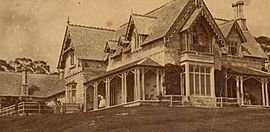Greycliffe House facts for kids
Quick facts for kids Greycliffe House |
|
|---|---|

Greycliffe House, Vaucluse, c. 1875
|
|
| General information | |
| Status | Complete |
| Type | House |
| Architectural style | Federation Arts and Crafts |
| Location | 21-23 Mona Road, Vaucluse, New South Wales |
| Country | Australia |
| Coordinates | 33°51′06″S 151°15′59″E / 33.8518°S 151.2664°E |
| Completed | c. 1852 |
| Client | John Reeve |
| Technical details | |
| Material |
|
| Design and construction | |
| Architect | John Hilly |
| Official name | Greycliffe House |
| Designated | 21 March 1978 |
| Reference no. | 2498 |
|
Invalid designation
|
|
| Official name | Greycliffe House - house, street fencing; Greycliffe Flats - house, grounds and sandstone retaining wall to street |
| Type | Built |
| Criteria | a., b., c., d., e., f., g. |
| Designated | 22 July 2005 |
| Reference no. | Local register |
Greycliffe House is an old, two-story house in Vaucluse, a suburb of Sydney, Australia. It was finished around 1852. The house has a special style called Federation Arts and Crafts. Greycliffe is listed on an old Australian heritage list and on the local heritage list for the Municipality of Woollahra.
Contents
History of Greycliffe House
Building the House
Greycliffe was built from strong Sydney sandstone. It has beautiful cedar wood inside and fancy plasterwork. The house was built for Fanny Wentworth, one of the daughters of William Charles Wentworth. Fanny married John Reeve, a rich man from England.
Mr. Reeve bought land at Shark Beach from William Wentworth. He asked an architect named John Hilly to design Greycliffe. The house was completed around 1852. A paved road, which was once the house's carriage drive, still leads to the building today.
Early Residents and Purpose
Mr. Reeve never actually lived in the house. He and his wife preferred to travel to England. Instead, Greycliffe was rented out to many important people in Sydney. One of the first people to live there was Colonel John George Nathaniel Gibbes (1787-1873). He was in charge of collecting customs duties for New South Wales.
The house was perfect for Colonel Gibbes. From its north-facing verandah, he could watch all the ships moving on Sydney Harbour. Colonel Gibbes and his wife, Elizabeth, lived at Greycliffe until 1859. After that, they moved to their new home, Yarralumla, in what is now Canberra. Today, Yarralumla is the official home of the Governor-General of Australia.
Public Ownership and Modern Use
After the Gibbes family left, many other private renters lived at Greycliffe. In 1911, the Government of New South Wales took ownership of the house. It was first used as a hospital for babies. Later, it became a centre to help mothers learn how to care for their infants.
In 1978, Greycliffe was added to the Sydney Harbour National Park. The park also includes the nearby recreational area known as Nielsen Park.
Architectural Features
Today, Greycliffe is a big, fancy, and well-kept Victorian house. It still has clear views of Sydney Harbour. The house has many pointed roof sections called gables. It also has a long entrance hall and a grand staircase. The decorative wooden boards on the roof edges are carved.
Stables are located behind the house. The gardens of the house stretch down to the beach. Natural bushland surrounds the back of the house. In 1897, a fire badly damaged the upstairs and roof. However, the house was repaired soon after.
Greycliffe has been used as a visitors' centre and the main office for the Sydney Harbour National Park. The house was also used as a filming location for the Bligh family in the 2013 Australian TV show A Place To Call Home.
Images for kids




